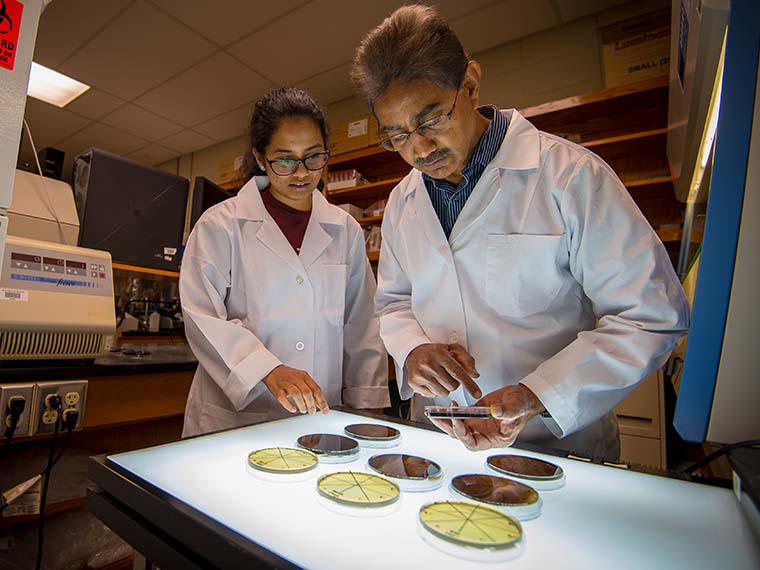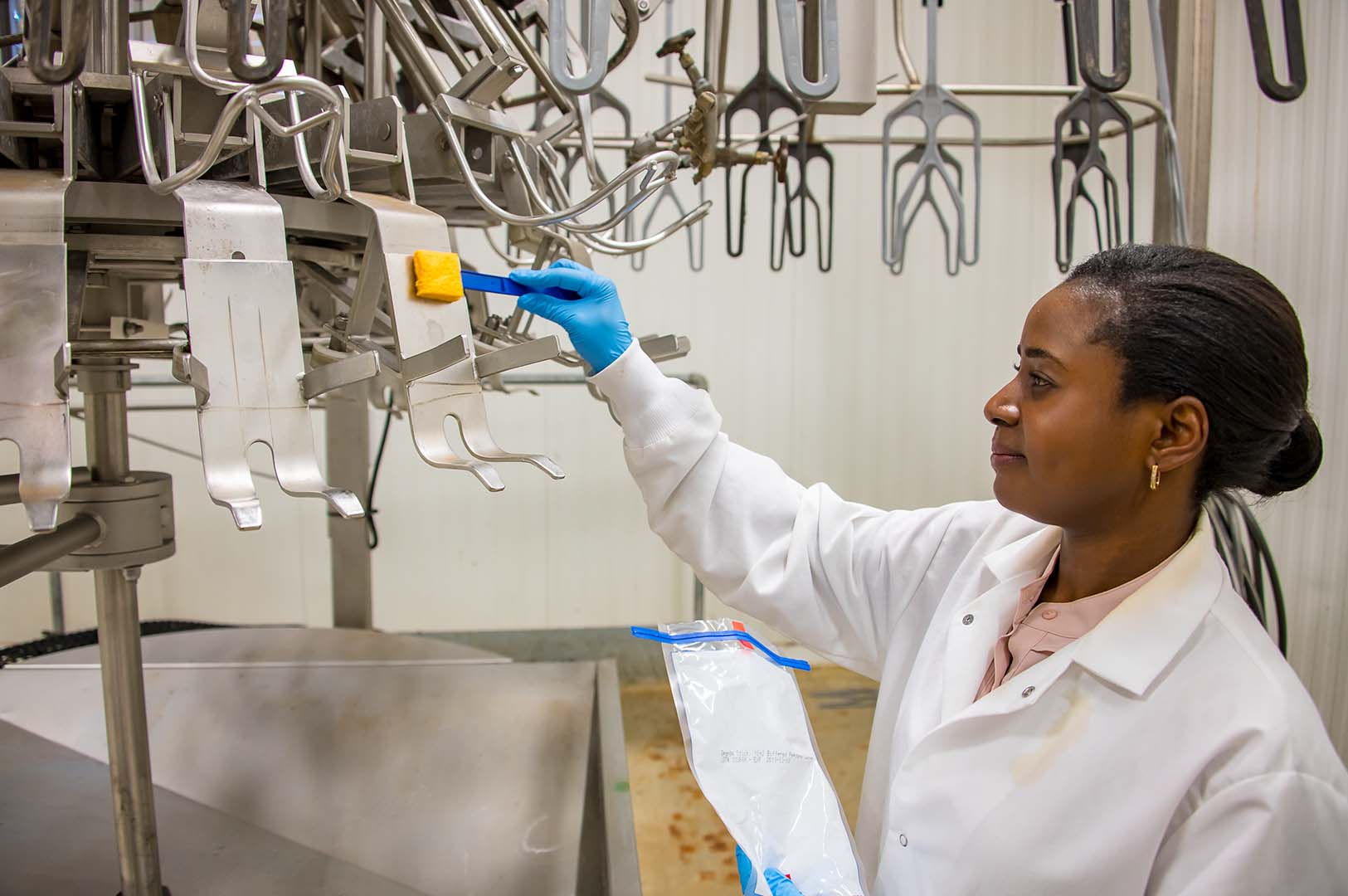The information presented on this page may be dated. It may refer to situations which have changed or people who are no longer affiliated with the university. It is archived as part of Mississippi State University's history.
Of the many suspects that cause food safety issues in kitchens and food processing plants, biofilms are a common culprit. MAFES scientists Dr. Ramakrishna Nannapaneni, who specializes in food science, nutrition and health promotion and Dr. Aaron Kiess, who specializes in poultry science, are taking a stand.
Biofilms are the growth of bacterial cells on surfaces that touch food. They can be notoriously difficult to detect, and can cause ongoing contamination in food preparation areas.
"On finding a contact surface such as a counter, the normal free-floating bacterial cells attach and grow as a biofilm. This creates a strong matrix of cells, which can survive under harsh environmental conditions. Biofilm matrixes, once formed, remain as a continuous source of cross contamination of food products in food processing environments," Nannapaneni stated.
These films can be caused by bacteria such as Listeria monocytogenes and Salmonella, both of which are human health concerns. Sixteen hundred people come down with listeriosis every year, and it especially impacts pregnant women, newborns, the elderly, and people with compromised immune systems. Salmonella impacts 1.2 million people in the United States every year, with one million of those cases caused by contaminated food.
Nannapaneni and Kiess hope to find out how these pathogenic bacteria adapt, persist, and survive in the food processing environment to cause food safety risks by discovering the nature of biofilms.
"While working with different strains of Listeria monocytogenes and Salmonella, we noticed that some strains form more biofilms than the other strains," Nannapaneni explained. "We later found that when exposed to sub-lethal stressors these bacterial cells trigger a stress response in order to survive lethal concentration of disinfectants and sanitizers."
In other words, when certain strains of L. monocytogenes and Salmonella are exposed to chemicals that don't completely kill them, they trigger defenses that help them survive higher concentrations of chemicals.
Even the physical structure of Salmonella changed after exposure to sublethal concentrations of disinfectant.
"Graduate students Tomi Obe and Mohit Bansal found that Salmonella has a tendency to develop as a large wavy colony type called a rugose, which was clearly noticeable after it had been exposed to sublethal concentrations of chlorine," Nannapaneni said.
Another student Divya Kode observed that rugose biofilm has increased tolerance against lethal treatments of sodium hypochlorite. Mohit Bansal later conducted scanning electron microscopy studies that revealed that rugose biofilm cells are densely embedded in a sticky matrix.
After these observations, the researchers decided to take a closer look at the phenomena by studying it in the food industry processing surfaces.
"Graduate student Nitin Dhowlaghar conducted an extensive survey of catfish processing plant environments. Through this work, we obtained four kinds of food-contact surfaces that are commonly used in food processing plants. He then determined the role of catfish mucus in biofilm formation by combining various concentrations of catfish mucus and strains of Salmonella, and observing the formation of biofilms on different food-contact surfaces," Nannapaneni explained.
Another student Piumi Abeysundara conducted similar research on food processing surfaces using whole cantaloupe extracts, in order to make the study more applicable to the fresh food industry.
The scientists found that all four commonly used food-contact surfaces, including stainless steel, polyethylene, polyurethane, and buna-n rubber supported biofilm formation by Salmonella and L. monocytogenes if low concentrations of food residues are present. They also discovered that a mixture of disinfectants was far more effective than single compound disinfectants for removal of biofilms.
Dr. Kiess's lab is also looking into how Salmonella survives on poultry processing equipment before and after cleaning cycles.
"We are examining the persistence of Salmonella on poultry processing equipment before and after sanitation cycles to understand the efficacy of antimicrobials that are commonly used in poultry processing plants," Kiess explained.
Chicken is the top protein choice for Americans across the country, providing a nutritious and inexpensive option for consumers. Like most food products, it can be contaminated by Salmonella, and so it is crucial to ensure that poultry producers know the best ways to battle it.
"Our next steps are to determine the nature of different Salmonella strains-after isolating them from the poultry processing environment-and to determine what concentration of disinfectant each strain requires in order to inhibit biofilm growth," Kiess said.
The researchers' ultimate goal is to better understand these biofilms, so that they can eliminate them once and for all.
The researchers expect to determine how biofilm cells become denser and stronger, and spread and what mechanisms govern cross-resistance. By discovering this, they hope to figure out how these tough biofilms can be eradicated to enhance food safety.
Concerned about Salmonella or Listeria contamination? There are simple measures you can take in your own kitchen: wash your hands fully before and after handling raw food, avoid washing raw meat, use a separate cutting board for raw meat, ensure that you cook meat and eggs to the correct temperature, and wash all counter tops and cutting boards with warm, soapy water before and after preparing meals.
This research was funded by the MAFES Food Safety Initiative and USDA-AFRI-NIFA grant funds.


